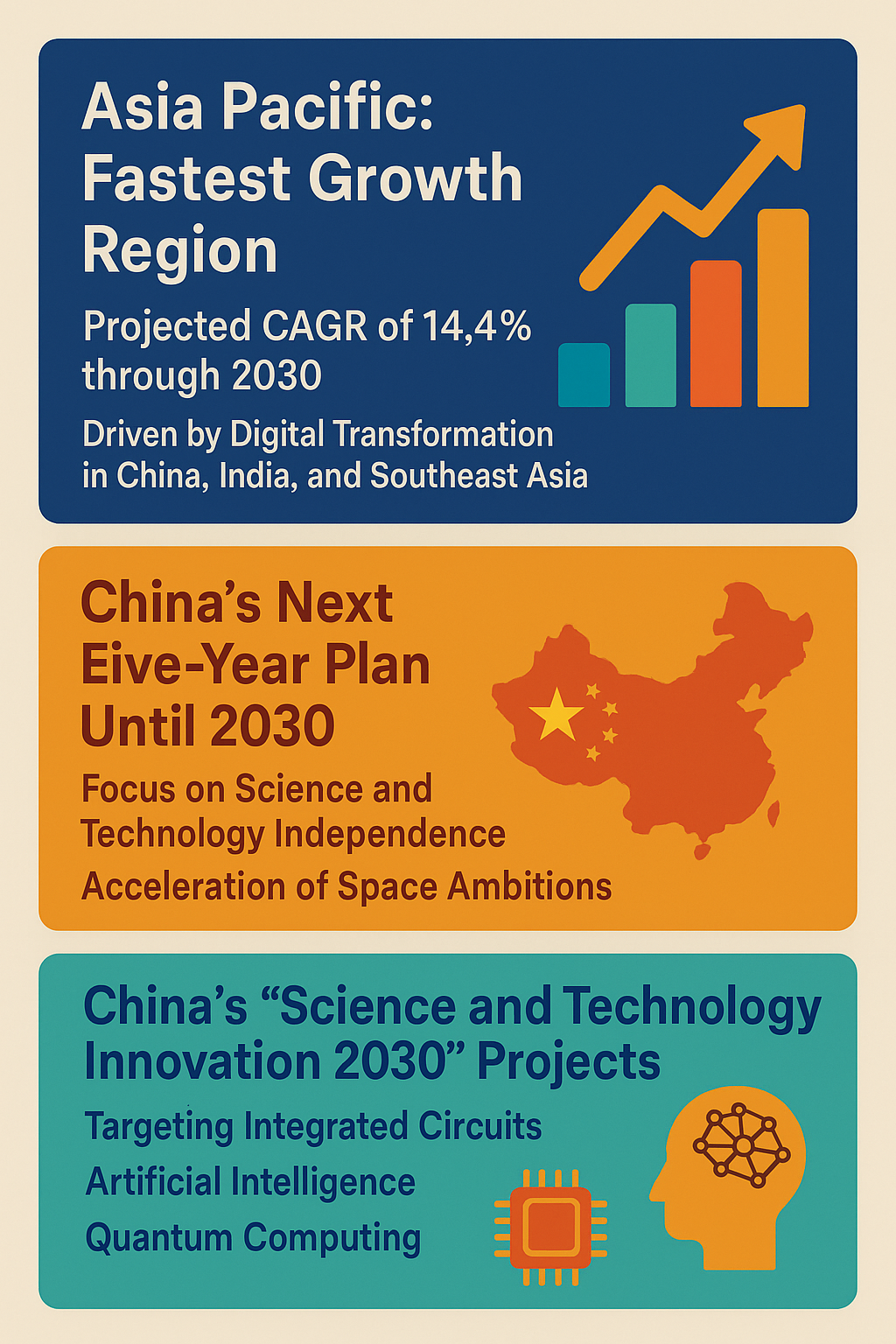Global Scans · China · Signal Scanner
China's Quest for Technological Independence: Emerging Weak Signals of AI and Quantum Computing Disruption
China’s intensified focus on achieving science and technology self-reliance through initiatives such as its “Science and Technology Innovation 2030” program signals a potential inflection point in the global technology landscape. Beyond headline goals, subtle indications show China is not only betting on large-scale investments in artificial intelligence (AI), integrated circuits, and quantum computing but also on creating rigid regulatory environments to shape innovation. These weak signals suggest an emerging trend toward a bifurcated global technology ecosystem, where tightly controlled innovation hubs operate under distinct paradigms, potentially disrupting global supply chains, research collaboration, and market dynamics across multiple industries.
What’s Changing?
China’s next Five-Year Plan through 2030 prioritizes technological independence with significant state funding aimed at reducing reliance on foreign suppliers and technologies. Its planned expenditure of approximately USD 55 billion in semiconductor research and development, AI, and quantum computing under “Science and Technology Innovation 2030” highlights a strategic choice to build deep, foundational capabilities in these fields (Tom's Hardware).
This massive and targeted spending coincides with China’s structured regulatory approach toward AI. The government has established a regulatory framework designed to encourage innovation, while maintaining tight control over AI development to mitigate potential risks and ethical concerns (Conventus Law). This balance in regulation may represent a new paradigm in AI governance, differing fundamentally from more liberal innovation ecosystems in the US and Europe.
Moreover, China is concurrently pushing to expand its private space industry and digital infrastructure in Asia-Pacific markets, with digital transformation leading to expected regional telecom growth at a compound annual growth rate (CAGR) of 14.4% through 2030 (Yahoo Finance, Channel News Asia). Advances in cloud infrastructure and chip technology also indicate an ambition to create a comprehensive ecosystem from quantum computing to AI-powered business process management (BPM) platforms (Introspective Market Research).
Diplomatic complexities remain, as China seeks relief from memory chip export restrictions essential for AI development, while the US reinforces efforts to limit China’s access to critical technologies, especially in semiconductors (Saxo). This dynamic may prompt China to accelerate indigenous chip manufacturing, quantum technology research, and AI ecosystems to circumvent supply chain vulnerabilities.
Finally, underlying risks of overcapacity in traditional and emerging tech sectors, including legacy semiconductors and green hydrogen electrolyzers, expose challenges in balancing rapid scaling with sustainable demand (MERICS).
Why is this Important?
China’s focused investment signals a potentially disruptive shift in the technological status quo. These efforts may accelerate the emergence of a parallel technology ecosystem, distinct from Western models, with tailored governance, advanced research, and integrated supply chains operating largely within China’s technological sphere.
The structured AI regulations may evolve into a global model for responsible AI development emphasizing control and risk mitigation, contrasting with more permissive innovation cultures. Such divergence might create challenges for multinational companies navigating differing compliance regimes.
Emerging dominance in quantum computing and semiconductors could dramatically alter global competitiveness, impacting industries reliant on high-performance computing, from pharmaceuticals to defense. If China achieves breakthroughs in these areas, it might disrupt current leadership held primarily by the US and its allies.
Accelerated space sector growth ties into these trends by expanding satellite-based communications and navigation infrastructure critical to AI, IoT (Internet of Things), and smart city projects across Asia-Pacific, thus reshaping regional tech power balances and commercial opportunities.
Implications
Industry, government, and research institutions worldwide might encounter a transformed landscape characterized by more localized technology ecosystems, stringent regulatory frameworks, and shifting supply chains. This new environment could require:
- Enhanced strategic partnerships and alliances that consider both geopolitical risks and technology governance differences.
- Investment in domestic R&D and supply chain resilience to mitigate disruptions caused by export restrictions and overcapacity imbalances.
- Greater focus on compliance regimes tailored for diverse regulatory environments, particularly in AI and emerging technologies.
- Continuous horizon scanning to identify weak signals such as China’s emerging quantum computing patents, nascent chip manufacturing capacities, and new AI governance policies that could foreshadow rapid shifts.
Moreover, organizations should prepare for a gradual fragmentation of global technology standards, necessitating adaptable product development and digital strategies to navigate bifurcated ecosystems.
Policymakers may find opportunities in dialogue frameworks that balance open innovation with technology security, mitigating the risk of decoupling while harnessing complementary strengths.
Questions
- How can organizations realign R&D investments to anticipate divergent technological ecosystems and compliance landscapes?
- What partnerships or alliances will best position industry players to leverage or mitigate the impacts of China’s technology policy shifts?
- How might emerging AI governance models in China influence global standards and expectations for responsible AI development?
- In what ways will advancements in quantum computing and integrated circuits reshape competitive dynamics across sectors like finance, healthcare, and defense?
- What strategies can reduce vulnerability to supply chain disruptions stemming from geopolitical tensions and overcapacity risks?
Keywords
China technology independence; AI regulation; Quantum computing; Semiconductor manufacturing; Digital transformation Asia-Pacific; Technology ecosystem bifurcation
Bibliography
- China plans to spend USD 55 billion on R&D in 2025 — semiconductor, AI, and quantum computing fields to benefit. Tom's Hardware. https://www.tomshardware.com/tech-industry/china-to-spend-usd55-billion-on-r-and-d-in-2025-semiconductor-ai-and-quantum-computing-fields-to-benefit
- Deep synthesis, not deepfake – How AI compliance works in China. Conventus Law. https://conventuslaw.com/featured-content/deep-synthesis-not-deepfake-how-ai-compliance-works-in-china/
- Asia Pacific will exhibit fastest growth with digital transformation driving telecom expense management market. Yahoo Finance. https://finance.yahoo.com/news/telecom-expense-management-market-intelligence-173100334.html
- China space industry growing private firms and tourism sector. Channel News Asia. https://www.channelnewsasia.com/east-asia/china-space-industry-growing-private-firms-tourism-5498921
- China urges US to ease memory chip export restrictions to advance AI development. Saxo Markets. https://www.home.saxo/en-sg/content/articles/macro/asia-market-quick-take-august-12-2025-12082025
- Beyond overcapacity: Chinese style modernization and clash of economic models. MERICS. https://merics.org/en/report/beyond-overcapacity-chinese-style-modernization-and-clash-economic-models
- Business process management market enabling digital transformation in Asia. Introspective Market Research. https://introspectivemarketresearch.com/reports/business-process-management-market/
